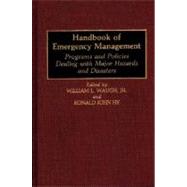
| Preface<BR> | |
| Introduction to Emergency Management by William L. Waugh, Jr., and Ronald John Hy<BR> | |
| The Function of Emergency Management by Ronald John Hy and William L. Waugh, Jr.<BR> | |
| Earthquakes by Richard T. Sylves<BR> | |
| Volcanic Hazards by William L. Waugh, Jr.<BR> | |
| Hurricanes by William L. Waugh, Jr.<BR> | |
| Floods by Beverly A. Cigler and Raymond J. Burby<BR> | |
| Tornadoes by Loran B. Smith and David T. Jervis<BR> | |
| Wildfire Hazards by Diane Moskow-McKenzie and John C. Freemuth<BR> | |
| Drought by Donald A. Wilhite<BR> | |
| Hazardous Material Transport Accidents by and Jeanette M. Trauth and Thomas J. Pavlak<BR> | |
| Nuclear Emergencies by Joan Aron<BR> | |
| Air Disasters by Margaret Baty<BR> | |
| Structural Failures by Ronald John Hy<BR> | |
| Public Health Emergencies by Caffilene Allen<BR> | |
| Civil Defense by Loran B. Smith<BR> | |
| The Utility of All-Hazard Programs by William L. Waugh, Jr., and Ronald John Hy<BR> | |
| Selected Bibliography<BR> | |
| Emergency Management Organizations and Information Sources<BR> | |
| Index |
The New copy of this book will include any supplemental materials advertised. Please check the title of the book to determine if it should include any access cards, study guides, lab manuals, CDs, etc.
The Used, Rental and eBook copies of this book are not guaranteed to include any supplemental materials. Typically, only the book itself is included. This is true even if the title states it includes any access cards, study guides, lab manuals, CDs, etc.